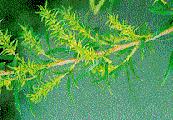
Dusky Willow
Salix exigua Nutt.
ssp. melannopsis (Nutt.) Cronq

Dusky Willow
Salix exigua Nutt.
ssp. melannopsis (Nutt.) Cronq
Dusky Willow is a short-lived deciduous shrub or small tree up to about 12 feet tall, with soft weak wood, and thin gray-green to brown bark. The twigs are space to moderate with loosely appressed wavy, curly hairs. Mature leaves are linear or oblong, toothed with a sub-entire up to 4 1/2 inches and equally green on both sides.. Staminate and pistillate flowers occur on separate plants as catkins. It flowers in May to July. The fruit is a narrowly ovoid capsule. They form thickets through the underground spread of root stickers. It is found almost exclusively in riparian habitats, occupying banks of major rivers and smaller streams, lakes and ponds, marshy areas, alluvial terraces, and ditches. It characteristically forms zones immediately adjacent to the water's edge. These areas are subjected to periodic flooding which often deposits sand and cobble below the high water mark. With severe annual flooding it may be the only shrub to survive in this zone. Although often found below the high water mark, it must have a portion of its crown out of the water during part of the summer to survive. The Dusky Willow may also occur on moist, well-drained benches and bottomlands. It normally does not exist in the under-story due to its shade intolerance, and is generally replaced by cottonwoods. Soils: It occurs on a wide range of soil textures, but usually occurs on soils derived from alluvial or fluvial parent material of mixed geologic origin. It also occurs on a wide range of soil types in eastern Idaho and western Wyoming. Dusky Willow communities occupy soils from fine-loamy or finer textures, to coarse-textured soils with up to 35 percent rock fragments. Nuttall recorded finding the Dusky Willow at Fort Hall growing on the alluvial upper banks of the River.
Planting:
Cuttings of mature wood of the current year's growth, November to February
in a sheltered outdoor bed or planted straight into their permanent position and
given a good weed-suppressing mulch. Very easy. Plant into their permanent
positions in the autumn.